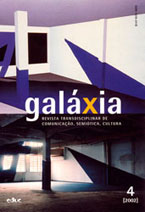<b>A exatidão no jornalismo à luz da condição semiótica da linguagem</b>
Resumo
Este texto discute a possibilidade da linguagem jornalística cumprir com seus ideais de exatidão, a partir de uma abordagem semiótica. A hipótese é que a linguagem jornalística, como sistema de signos que é, não consegue se desvencilhar de sua condição semiótica. Por mais que os jornalistas se esforcem para representar os fatos tal como ocorreram, sempre existirão aspectos não contemplados na representação jornalística da realidade. A linguagem jornalística consegue, no máximo, tomar o lugar de seu objeto, representando-o perante o público. Esta hipótese é analisada à luz das condições de parcialidade, referencialidade e alteridade do signo, tal como Peirce as descreve. A questão a investigar é até que ponto a linguagem jornalística é capaz de cumprir com seus ideais de exatidão, sendo ela uma representação dos fatos da realidade. Palavras-chave linguagem jornalística - exatidão - realidade Abstract This text discusses the possibility that the journalistic language meet with its ideals of exactness taking into account semiotic approach. The hypothesis is that the journalistic language, being a system of signs, cannot be detached from its semiotic condition. In spite of the journalists` efforts to portray the facts just as they happened, there will always be unaccounted aspects in that representation. At the most, the journalistic language may take place of its object, representing it before the public. This hypothesis is analyzed considering the conditions of partiality, referentiality and alterity of the sign confronted with this object, as proposed by Peirce. The fundamental question to be examined is just how far can the journalistic language go in its ideals of exactness as a representation of reality. Keywords journalistic language - exactness – realityDownloads
Publicado
2007-02-22
Como Citar
Pereira, M. F. (2007). <b>A exatidão no jornalismo à luz da condição semiótica da linguagem</b>. GALÁxIA. Revista Interdisciplinar De Comunicação E Cultura, (4). Recuperado de https://revistas.pucsp.br/index.php/galaxia/article/view/1281
Edição
Seção
Artigos | Articles
Licença
Os autores de artigos publicados mantêm os direitos autorais de seus trabalhos, licenciando-os sob a licença Creative Commons CC-BY, que permite que os artigos sejam reutilizados e distribuídos sem restrição, desde que o trabalho original seja corretamente citado. Os autores concedem para GALÁxIA. Revista Interdisciplinar de Comunicação e Cultura o direito de primeira publicação.



 Este obra está licenciada com uma Licença
Este obra está licenciada com uma Licença 